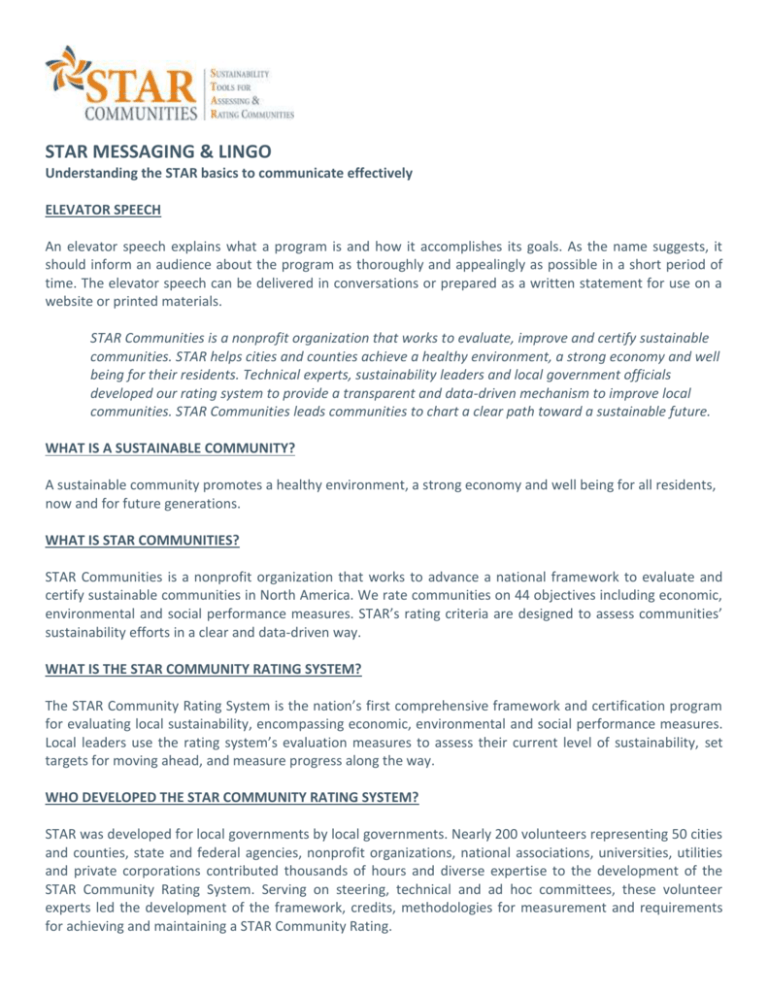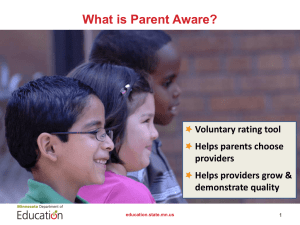- STAR Communities
advertisement

STAR MESSAGING & LINGO Understanding the STAR basics to communicate effectively ELEVATOR SPEECH An elevator speech explains what a program is and how it accomplishes its goals. As the name suggests, it should inform an audience about the program as thoroughly and appealingly as possible in a short period of time. The elevator speech can be delivered in conversations or prepared as a written statement for use on a website or printed materials. STAR Communities is a nonprofit organization that works to evaluate, improve and certify sustainable communities. STAR helps cities and counties achieve a healthy environment, a strong economy and well being for their residents. Technical experts, sustainability leaders and local government officials developed our rating system to provide a transparent and data-driven mechanism to improve local communities. STAR Communities leads communities to chart a clear path toward a sustainable future. WHAT IS A SUSTAINABLE COMMUNITY? A sustainable community promotes a healthy environment, a strong economy and well being for all residents, now and for future generations. WHAT IS STAR COMMUNITIES? STAR Communities is a nonprofit organization that works to advance a national framework to evaluate and certify sustainable communities in North America. We rate communities on 44 objectives including economic, environmental and social performance measures. STAR’s rating criteria are designed to assess communities’ sustainability efforts in a clear and data-driven way. WHAT IS THE STAR COMMUNITY RATING SYSTEM? The STAR Community Rating System is the nation’s first comprehensive framework and certification program for evaluating local sustainability, encompassing economic, environmental and social performance measures. Local leaders use the rating system’s evaluation measures to assess their current level of sustainability, set targets for moving ahead, and measure progress along the way. WHO DEVELOPED THE STAR COMMUNITY RATING SYSTEM? STAR was developed for local governments by local governments. Nearly 200 volunteers representing 50 cities and counties, state and federal agencies, nonprofit organizations, national associations, universities, utilities and private corporations contributed thousands of hours and diverse expertise to the development of the STAR Community Rating System. Serving on steering, technical and ad hoc committees, these volunteer experts led the development of the framework, credits, methodologies for measurement and requirements for achieving and maintaining a STAR Community Rating. WHAT IS IN THE RATING SYSTEM? The STAR Community Rating System is organized around 7 thematic Goal Areas: Goal Area Built Environment Climate & Energy Education, Arts & Community Economy & Jobs Equity & Empowerment Health & Safety Natural Systems Purpose and Intent Achieve livability, choice, and access for all where people live, work, and play Reduce climate impacts through adaptation and mitigation efforts and increase resource efficiency Empower vibrant, educated, connected, and diverse communities Create equitably shared prosperity and access to quality jobs Ensure equity, inclusion, and access to opportunity for all citizens Strengthen communities to be healthy, resilient and safe places for residents and businesses Protect and restore the natural resource base upon which life depends An eighth category, Innovation & Process, allows communities to get extra credit in areas where they excel and propose new credits to support the evolution of sustainability practice. Within the 7 Goal Areas, there are 44 Objectives. See the following framework of Goals & Objectives: WHY IS STAR COMMUNITIES NEEDED? Sustainability means different things to different people, so STAR provides a clear, data-driven approach to assessing communities’ sustainability efforts. The STAR framework helps communities assess their efforts in seven key areas and define sustainability for themselves. This robust framework is necessary for communities to credibly track their progress toward overall sustainability objectives and to allow communities to compare progress with each other. WHO IS ELIGIBLE? While anyone can download use the STAR Community Rating System as a guide to community sustainability, it was designed for use by local (town, city, county) governments in the United States. The primary applicant for STAR certification must be a local government. Other community partners, organizations, universities, consultants and federal agencies can become STAR Affiliates to support STAR Communities' mission. HOW DOES IT WORK? Communities sign up as a Member STAR Community and select from different levels of support as they work to assess and certify their sustainability efforts. The Leadership program provides the highest level of support from STAR Communities’ staff, including a dedicated STAR coordinator and ongoing educational webinars about issues related to the rating system. For communities that pursue certification, the rating system encompasses economic, environmental and social performance measures for both local governments and the broader community. Communities must fill out an online application detailing their achievements across 44 sustainability objectives, with a total of 526 different measurable indicators. STAR Communities’ verification team then reviews the community’s application as an independent third-party and awards a rating based upon a total cumulative score of points achieved. WHAT ARE THE BENEFITS OF STAR? The STAR Community Rating System provides a roadmap to help evaluate, assess and improve communities’ economic, environmental and social performance measures and become healthier and stronger. STAR allows cities and counties to set a clear path for sustainability with helpful tools that measure and track progress towards meaningful results that save money and improve communities. WHICH COMMUNITIES ARE INVOLVED? WHO HAS BEEN CERTIFIED? The list of STAR communities is always growing! As of August 2014, more than 80 communities are currently engaged with STAR in some way, representing more than 34 million people. See an updated map of communities here. STAR communities are diverse in size, geography, and demographics. STAR communities are as large as Houston, TX (2.2 million population) and as small as Nederland, CO (1,478 population). As of summer 2014, 20 communities have been certified – see the list of certified communities here. HOW DOES THE CERTIFICATION PROCESS WORK? The primary applicant for a STAR Community Rating is a local government - a town, city or county government. Participating local governments fill out the online application by providing data on a variety of community sustainability indicators and coordinating data collection from outside agencies and community partners. Once a community submits a completed application, STAR Communities’ staff review and verify data for accuracy, and then assign a rating upon a total cumulative score of points achieved out of a maximum of 720 points. Communities receive a rating based on the number of points achieved across the menu-based rating system. Communities choose the measures that they would like to report on and are not required to submit on all measures. This allows local governments to report on the objectives that are most important and relevant to their communities. Since STAR is a menu and communities decide which measures to report on, the final scores do not provide a true head-to-head comparison. Instead, the STAR Community Rating System includes 3 certification levels, making it a rating (not a ranking) system. Points required for the certification levels are as follows: 3-STAR Community - 200-399 points o Recognized for sustainability leadership 4-STAR Community - 400-599 points o Recognized for national excellence 5-STAR Community - 600+ points o Recognized as top tier achiever in national sustainability A STAR Community Rating lasts for 3 years after the certification date. WHAT IS THE LEADERSHIP PROGRAM? Modeled after the successful STAR Pilot Program, the Leadership STAR Community Program supports a cohort of cities, towns and counties as they collect and report data in order to receive a certified STAR Community Rating. Leadership STAR Communities have extensive access to STAR Communities staff and on-call experts, online tools, training programs (both web-based and in-person), technical assistance and other services associated with the STAR Community Rating System. Through this one-year program, Leadership STAR Communities gain tools to measure progress towards a common set of sustainability metrics; access to STAR’s online platform to track the community’s sustainability data; opportunities to learn best practice from other communities; and assistance in sustainability messaging and storytelling. At the end of the year, communities apply for STAR certification. CONTACT: If you have questions or require more information, please contact: Lacey Shaver Outreach Coordinator, STAR Communities lacey@starcommunities.org (855) 890-7827 ext. 105






